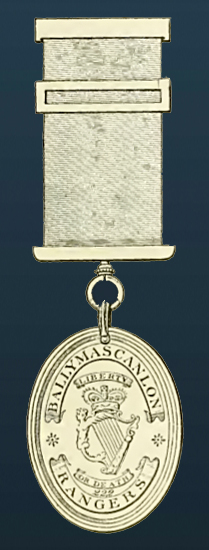Ballymascanlon Rangers Lodge No. 222 Volunteer Medal.
The Journal of The Royal Society of Antiquaries of Ireland, Volume III, Fifth Series, Pages 335-336.
The Society again met in the Lecture Theatre of the Crawford Municipal School of Science and Art at 8 o'clock, p.m., Robert Day, F.S.A., M.R.I.A., High Sheriff of Cork, Vice-President, in the Chair.
|
The Chairman exhibited "A Medal and Buttons of the Irish Volunteers," with the following description:- "I have already in the pages of our Journal described[1] some Medals of the Volunteers. I have now the renewed pleasure of illustrating another which is of more than ordinary interest. It is of engraved silver work, oval in form, and is two inches in length, by one and a-half inches wide. Obverse upon a garter divided in the centre at each side by a star "Ballymascanlon Rangers,"and within the garter, the harp crowned with smaller garters above and below the arms, having the motto "Liberty" "or Death" and the figures “222”. [1] Journal, Vol. I, Fifth Series (1891), pp459, 591.
|
|
Reverse - Upon the corresponding garters, 'We Struggle for Liberty,' and ' The Volunteers of Ireland.' In the centre of the field are nine of the volunteers, grouped as three Light Infantry, three men of the Line, and three Grenadiers: beneath their feet the owner's name 'Jno. Thompson,' and above the points of the bayonets with which the men are armed three masonic groupings. In the centre the square and compass enclosing the letter G. At its left the hour-glass resting on a book; and on the right the level, rule, and mallet. It is more than probable that the '222' is the number of Thompson's Masonic Lodge. The medal has its original scarlet ribbon, clasp, and suspender, and is of peculiar interest, illustrating the character of the uniforms worn by this County Louth Regiment. |
"Mr. F. E. Crossle of Newry has identified many of the Masonic lodges in Ireland with the Volunteers of ''82,' and this medal of Thompson's, while primarily a decoration of the Rangers, is also an enduring record that either a Lodge of Freemasons was in the regiment, or else that the Rangers themselves constituted a Masonic Lodge and a Masonic company of Volunteers.[2]
"M'Nevin laments the difficulty that he experienced in ascertaining the colours of the various volunteer uniforms, and is unable to describe that worn by the Ballymascanlon Rangers,[3] the commanding officer of which was Captain R. M'Neale.
"To further illustrate this subject I have brought two buttons of the Cork Artillery Volunteers, whose uniform was blue faced scarlet lace, and whose commander was Captain Richard Hare, junior. The buttons are circular and one and a-half inches in diameter, in a copper frame, glazed, and beneath the convex glass, painted on the flat, and in the background two towers, probably the 'King's' and 'Queen's' Castles, and in the foreground, behind a piece of ordnance, three soldiers with firearms standing at attention, and in the uniform and colours of this old Cork Corps. Such buttons could not have been worn by the rank and file of this regiment, but would probably have been used by the commissioned officers on special occasions."
[2] "History of the Volunteers." (Dublin: Duffy, 1848.)
[3] The parish of Ballymascanlon is remarkable for its great cromlech, the covering-stone of which measures 12 feet x 6 feet, and is computed to weigh forty tons. It is known as " The Giant's Load," and is illustrated and described in the Gentlemans Magazine for 1762, and in Wright's " Louthiana," p. 12.



